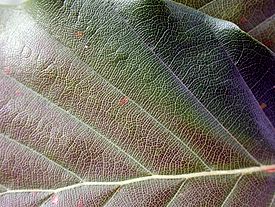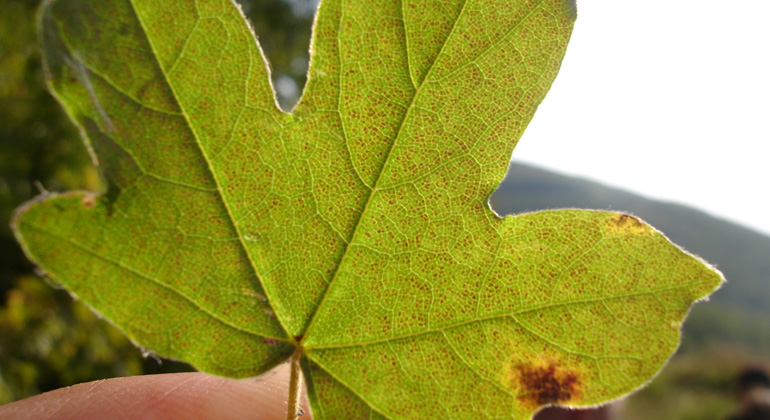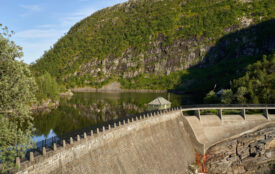Ozone stresses deciduous forests across Europe
Ozone still causes visible damage to the foliage of European deciduous trees, as shown by a large-scale study led by the Swiss Federal Institute for Forest, Snow and Landscape Research WSL.
The researchers found that some plants under certain environmental condition react particularly sensitively to ozone, which is toxic at ground level. Such plants are therefore well-suited as an early warning system.
In a transnational field study, researchers have found significant visible symptoms caused by toxic ozone on the leaves of broadleaved trees – and this, despite the fact that the total ozone concentration remained stable or decreased slightly between 2005 and 2018.
These visible foliar symptoms (abbreviated as VFS) were mainly observed on the upper side of the leaves as thin, light green, reddish, or dark brown pinhead-sized spots between the leaf veins. Older leaves were more severely affected. «The cells of these leaves were damaged. We cannot yet say what impact such a damage has on the overall health of the plants,» comments Marco Ferretti, the lead researcher. The large-scale study was coordinated by the Swiss Federal Institute for Forest, Snow and Landscape Research WSL and conducted under the auspices of ICP Forests, a UNECE program in which Switzerland (and WSL) play an important role.
The researchers found significant VFS in parts of France, Germany, Switzerland, Lithuania, and Greece. Lesser symptoms were found in Croatia, Spain, Italy, and parts of Central and Eastern Europe.
Some species are particularly sensitive

Among the studied species, the European beech (Fagus sylvatica) showed the highest frequency of symptoms. Overall, a correlation was observed between symptoms and certain leaf characteristics such as specific leaf area (ratio of leaf area to leaf dry mass) and leaf thickness. “Sensitive plants can serve as an early warning system for ozone effects on vegetation,” says Ferretti. Other species are apparently less sensitive. For example, due to its leaf characteristics and growing conditions, the western strawberry tree (Arbutus unedo) displayed no or only minimal leaf symptoms, even at high ozone levels.
Consider the entire species diversity
According to Ferretti, it is precisely because plants react so differently to ozone that it is crucial to study the entire plant community and not just selected species at one location. This is the only way to get a holistic picture of the potential effects of ozone on the entire deciduous forest in a particular region. “The susceptibility of a deciduous forest to ozone varies with its species composition, even at the same ozone concentration,” explains Ferretti.
The study also shows that foliar symptoms are not always directly proportional to the ozone concentration. For example, higher incidences of foliar symptoms were observed in the Alpine and continental regions with lower ozone concentrations, while fewer symptoms occurred in the Mediterranean regions with high concentrations. According to the authors, this suggests that ozone concentration alone does not determine the susceptibility of deciduous forests to ozone. Other factors such as vegetation (e.g., species composition), atmosphere, and soil water availability also influence susceptibility to ozone.
Researchers recommend longer monitoring
The research team collected and analyzed data between April and September and from 2005 to 2018 in 20 countries. Out of the 149 plant species studied, 57 (38.3%) showed visible foliar symptoms due to ozone. These were observed at 57 of the 91 locations studied (62.6%).
The authors of the study recommend long-term and continuous monitoring to understand the effects of ozone on the health, growth and biodiversity of deciduous forests.
UNECE and ICP Forests
The United Nations Economic Commission for Europe (UNECE) was set up in 1947. UNECE’s major aim is to promote pan-European economic integration. In 1979, the Air Convention, the first international multilateral agreement to combat air pollution, was signed by 32 Countries (now 51 Parties). Within the Air Convention, the International Cooperative Programme on Assessment and Monitoring of Air Pollution Effects on Forests (ICP Forests) was launched in 1985 in response to widespread public and political concern over extensive forest damage observed in Europe in the early 1980s. The objectives of ICP Forests are to monitor the effects of anthropogenic (particularly air pollution) and natural stress factors on the condition and development of forest ecosystems across Europe and beyond. It also aims to contribute to a better understanding of cause-effect relationships in forest ecosystem functioning. Currently, 42 countries are part of ICP Forests. Marco Ferretti has served as Chairman of the ICP Forests since 2017.
- Publikation: Ferretti M., Cailleret M., Haeni M., Trotsiuk V., Apuhtin V., Araminiene V., … Schaub M. (2024) The fingerprint of tropospheric ozone on broadleaved forest vegetation in Europe Ecol. Indic. 158, 111486 (16 pp.). https://doi.org/10.1016/j.ecolind.2023.111486Institutional Repository DORA
QUELLE
Eidg. Forschungsanstalt für Wald, Schnee und Landschaft WSL 2024








